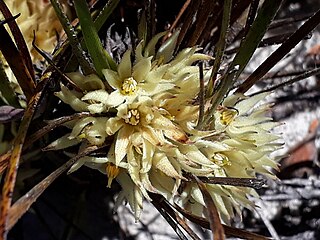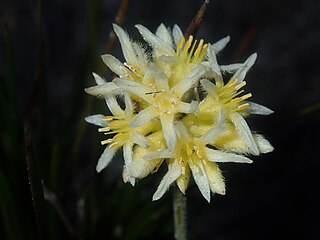
Conostylis setigera, commonly known as bristly cottonhead, is a rhizomatous, tufted perennial, grass-like plant or herb in the family Haemodoraceae and is endemic to the south-west of Western Australia.

Conostylis aculeata, commonly known as prickly conostylis, is a flowering, tufted perennial plant in the family Haemodoraceae. It has flat leaves and yellow, hairy, tubular flowers. It is endemic to the south-west of Western Australia.

Conostylis aurea, commonly known as golden conostylis, is a plant in the bloodwort family Haemodoraceae. It is endemic to the south-west of Western Australia.

Conostylis androstemma is a tufted perennial plant species in the family Haemodoraceae. It is endemic to the south-west of Western Australia. Plants grow to between 10 and 30 cm high and produce cream to pale yellow flowers between May and August in the species' native range.
Conostylis wonganensis, known as Wongan conostylis, is a rhizomatous, tufted, perennial grass-like plant or herb in the family Haemodoraceae and is an endemic of Southwest Australia. It has glabrous leaves and creamy-yellow, tubular flowers.

Conostylis breviscapa is a rhizomatous, tufted perennial, grass-like plant or herb in the family Haemodoraceae and is endemic to the south-west of Western Australia. It has flat leaves and yellow, hairy, tubular flowers.

Conostylis canteriata is a rhizomatous, tufted perennial, grass-like plant or herb in the family Haemodoraceae and is endemic to the south-west of Western Australia. It has stilted roots, flat leaves, and pale lemon-yellow tubular flowers.

Conostylis caricina is a flowering plant in the family Haemodoraceae and is endemic to the south-west of Western Australia. It is a rhizomatous, tufted perennial, grass-like plant or herb with flat leaves and heads of 6 to 8 creamy-yellow flowers.

Conostylis festucacea is a rhizomatous, tufted or proliferous perennial, grass-like plant or herb in the family Haemodoraceae, and is endemic to the south-west of Western Australia. It has cylindrical or flat leaves and yellow flowers.

Conostylis juncea is a rhizomatous, tufted perennial, grass-like plant or herb in the family Haemodoraceae, and is endemic to the south-west of Western Australia. It has cylindrical or flat leaves and yellow flowers on a short flowering stem.
Conostylis latens is a rhizomatous, tufted perennial, grass-like plant or herb in the family Haemodoraceae and is endemic to the south-west of Western Australia. It has flat, green, usually hairy leaves, and greenish-yellow, tubular flowers.

Conostylis laxiflora is a rhizomatous, tufted perennial, grass-like plant or herb in the family Haemodoraceae and is endemic to the south-west of Western Australia. It has flat, glabrous leaves, and yellow, tubular flowers.

Conostylis prolifera, commonly known as mat cottonheads, is a rhizomatous, tufted, stoloniferous, perennial, grass-like plant or herb in the family Haemodoraceae and is endemic to the south-west of Western Australia. It has flat, glabrous leaves, and yellow and cream-coloured, tubular flowers.
Conostylis resinosa is a rhizomatous, tufted perennial, grass-like plant or herb in the family Haemodoraceae and is endemic to the south-west of Western Australia. It has flat, shiny leaves, yellow, tubular flowers and is similar to C. aurea.

Conostylis robusta is a rhizomatous, tufted, stoloniferous, perennial, grass-like plant or herb in the family Haemodoraceae and is endemic to the south-west of Western Australia. It has flat, green leaves with bristles on the edges, and heads of yellow flowers on a relatively long flowering stem.
Conostylis rogeri is a rhizomatous, tufted perennial, grass-like plant or herb in the family Haemodoraceae and is endemic to a small area in the south-west of Western Australia. It has small tufts, flat leaves, and a single pale yellow, tubular flower.

Conostylis seminuda is a rhizomatous, tufted perennial, grass-like plant or herb in the family Haemodoraceae and is endemic to a small area in the south-west of Western Australia. It has flat leaves and golden yellow, tubular flowers.

Conostylis setosa, commonly known as white cottonhead, is a rhizomatous, tufted perennial, grass-like plant or herb in the family Haemodoraceae and is endemic to the south-west of Western Australia. It has flat leaves and white, or pinkish maroon to purple flowers

Conostylis teretifolia is a rhizomatous, tufted, perennial, grass-like plant or herb in the family Haemodoraceae and is endemic to the south-west of Western Australia. It has flat leaves, short stems and yellow to reddish, tube-shaped flowers.

Conostylis teretiuscula is a rhizomatous, tufted perennial, grass-like plant or herb in the family Haemodoraceae and is endemic to the south west of Western Australia. It has flat leaves and yellow, tube-shaped flowers.

















